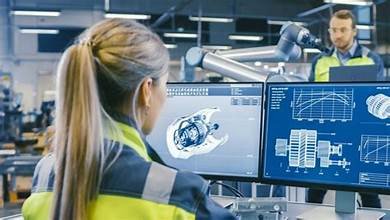Prologue to Mechanical Interaction Computerization

In a period where organizations are persistently looking for ways of streamlining their tasks and remain cutthroat, Mechanical Cycle Robotization (RPA) arises as an extraordinary power. Envision a reality where tedious and ordinary undertakings are executed faultlessly without human mediation, permitting gifted workers to zero in on essential reasoning and development. This is the commitment of RPA – a mechanical development that holds the possibility to reshape the scene of business processes.
**What RPA is: Another Period of Automation**
At its center, RPA is a state of the art innovation that utilizes programming robots, ordinarily alluded to as “bots,” to imitate human collaborations with computerized frameworks. These bots are fastidiously modified to explore through UIs, input information, perform estimations, and even speak with different frameworks similarly as a human administrator would. The enchanted lies in the way that RPA can execute these undertakings with unmatched precision and productivity, opening up HR from the weight of monotonous and rule-based exercises.
**Simplifying Routine Activities:
How RPA Works**
The core of RPA is its capacity to automate procedures that are predetermined. Ponder routine information section, data move among frameworks, and producing normalized reports. Customarily, these assignments required human inclusion, consuming important time and presenting the gamble of human blunders. RPA changes the game by empowering organizations to make work processes that guide bots through these errands, guaranteeing that they are executed reliably, precisely, and nonstop.
Comparison of RPA and Traditional Automation**
While traditional automation has long been a part of business procedures, RPA advances automation to a new level of sophistication and adaptability. RPA, in contrast to its predecessors, does not necessitate complex coding or significant system modifications. It works as an overlay, working flawlessly with the connection points and applications currently set up. Implementation is sped up, costs are reduced, and ongoing operations are minimally disrupted as a result of this agility.
**The Promise of Agility and Efficiency**
The pursuit of operational efficiency is the primary impetus for RPA adoption. By entrusting bots with routine undertakings, organizations can encounter a flood in efficiency. However, it doesn’t stop there – the advantages reach out to exactness and consistence. RPA bots are much less likely to make mistakes than humans because they don’t get tired or distracted. This is especially essential in enterprises that request careful scrupulousness, like money, medical services, and assembling.
**The Way Ahead: Embracing RPA**
As organizations keep on developing in a computerized age, the reconciliation of RPA into functional procedures turns into a goal. The capacity to offload tedious assignments to bots increments productivity as well as enables workers to participate in undertakings that require imagination, critical thinking, and human collaboration. It is a move in the direction of a workforce that is more evenly split, with humans and bots working in perfect harmony to get amazing results.
In the accompanying segments of this article, we will dig further into the horde advantages of RPA, investigate certifiable instances of its execution across different enterprises, and give bits of knowledge into the accepted procedures for fruitful RPA reception. As the shade ascends on this mechanical development, RPA’s groundbreaking potential turns out to be clear – it’s not just about computerizing errands; It’s about opening the door to a new era of business innovation and efficiency.
Advantages of RPA for Functional Productivity
In our current reality where organizations are continually endeavoring to accomplish more with less, Mechanical Cycle Mechanization (RPA) arises as an amazing asset that improves tasks as well as drives associations toward unrivaled degrees of proficiency. This revolutionary technology does not merely focus on task automation; it’s tied in with changing the manner in which organizations capability by outfitting the capacities of programming robots. Let’s look at how RPA reshapes the operational efficiency landscape and the numerous advantages it offers.
**1. Enhanced Productivity and Throughput**
The capacity to work tirelessly and accurately is at the heart of RPA. RPA bots work nonstop, getting done with jobs at speeds past human limit. This means an outstanding expansion in efficiency and a huge decrease in time required to circle back. Unremarkable and redundant undertakings that once impeded human workers are presently executed quickly and without mistake, permitting groups to zero in on higher-esteem exercises that drive development and advancement.
**2. Exactness and Blunder Reduction**
Human mistakes are unavoidable, especially in errands that include manual information passage and routine estimations. This risk is eliminated by RPA, which completes tasks with unparalleled precision. Bots adhere to predefined guidelines fastidiously, guaranteeing that information is input accurately, estimations are without blunder, and consistence prerequisites are met reliably. The outcome is a decrease in expensive errors, information disparities, and resulting remedial activities.
**3. Consistency and Standardization**
Irregularities in cycles can prompt functional shortcomings and upset navigation. By adhering to predefined workflows and rules, RPA enforces consistency. This standardization guarantees uniform execution of all tasks, regardless of volume or complexity. The outcome is further developed information quality, solid detailing, and a smoothed out review trail – basic parts of a well-working association.
**4. Versatility without Complexity**
Conventional robotization strategies frequently require complex reconciliations and custom coding, making versatility an overwhelming undertaking. RPA changes this account. With minimal effort, bots can be easily replicated and applied to new processes. RPA scales seamlessly to accommodate increased workloads without causing significant disruptions to ongoing operations as your company expands or responds to shifting market demands.
**5. Further developed Client Experience**
In a client driven business scene, functional proficiency straightforwardly influences consumer loyalty. By ensuring prompt responses, prompt issue resolution, and accurate data processing, RPA enhances customer experiences. With bots taking care of routine client connections, human representatives can zero in on building connections, giving customized help, and tending to complex client needs.
**6. Cost Reserve funds and Asset Optimization**
The designation of HR to tedious undertakings is an underutilization of abilities and potential. RPA empowers organizations to allot human ability to errands that request decisive reasoning, inventiveness, and critical thinking. This boosts the worth of your labor force as well as prompts cost investment funds through expanded proficiency and decreased functional above.
**7. Consistence and Review Trail**
Ventures represented by severe administrative structures, for example, money and medical services, benefit colossally from RPA’s review trail capacities. Each activity performed by a RPA bot is reported and recognizable, making a straightforward record that is imperative for consistence detailing and reviews. In addition to reducing compliance risks, this level of traceability also speeds up the audit process.
**8. Quick return for capital invested and Long haul Value**
The execution of RPA frequently yields quick profits from speculation. Costs can be directly reduced by optimizing resources, reducing errors, and increasing efficiency. In addition, RPA’s ability to adapt to shifting business requirements and its potential to evolve alongside emerging technologies are its long-term advantages.



